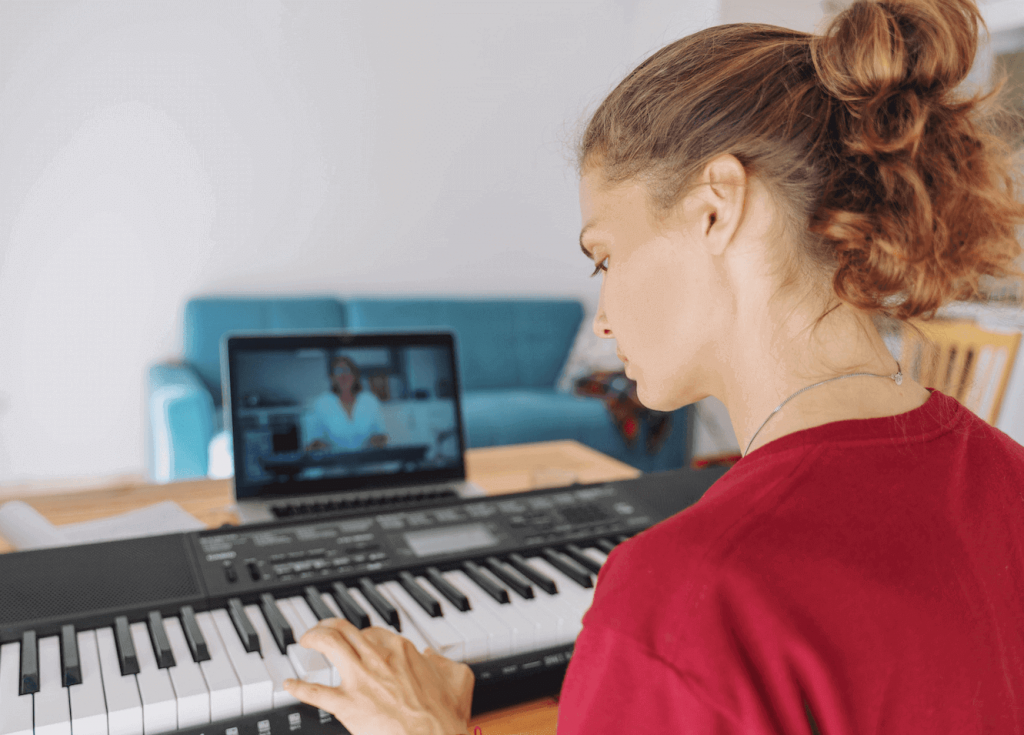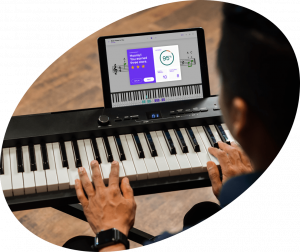Thanks to advancements with the internet and the devices used to connect to it, we’re living in a time like no other, where information about practically anything and everything is easily accessible – often from the comfort of one’s own living room.
And given the curious nature of humans, it’s no surprise that with all of this wealth of information in the palm of our hands (thank you smartphones), many take advantage and teach themselves new skills. One of the more popular things that people try to teach themselves is how to play an instrument, specifically the piano.
If you’re interested in learning how to teach yourself to play piano, then you’re in the right place! In this post, we’re going to take a look at how you can learn piano by all by yourself, outlining some of the best ways to set yourself up for success!
Let’s dive right in!
Step-by-step approach to learning piano yourself
Being a self-taught pianist, I speak from experience when I say that learning music, in a lot of ways, is like learning math in that they’re both topics that are best learned in a cumulative fashion. It’s better to learn concept A, then build on it with concept B, then C, then D, etc.
For example, in math, it’s better to first learn how to add as it would then make understanding multiplication easier. And it’s better to first learn how to subtract as it would then make understanding division easier. In music, the cumulative approach is very similar. It’s better to first learn what a whole note is as it would then make understanding a half note easier. And it’s better to first learn the musical alphabet as it would then make understanding how they’re mixed and matched to build chords much easier.
Because of the cumulative nature of learning music, it’s important when teaching yourself piano that you use a resource that teaches the piano in a step-by-step, cumulative approach. Whether you’re relying on video lessons, text instructions, or any other medium, if the information you’re presented with isn’t organized in a step-by-step way, it will be too easy to get lost and frustrated. I mean, can you imagine trying to learn algebra without first understanding how to add, subtract, multiply, and divide? Nightmare!
Break your learning down into manageable chunks
Once you’ve found a resource that breaks the concepts of the piano down in a step-by-step approach, you’ll next want to ensure that the information is delivered in small, manageable chunks. I’m not going to lie, there’s a lot to learn when it comes to music, but that doesn’t mean that you need to learn it all overnight! You want to be able to learn things little-by-little as it’s the best way to understand and retain what you’ve been taught. Otherwise, everything will feel very overwhelming, very fast.
Start off by learning something small, like the musical alphabet (A, B, C, D, E, F, G). Then, use that information to learn how those letters name the keys on your piano. From there, you can use that information to learn how the alphabet just repeats across all 88 keys. And then you can use that information to learn how each key is represented on sheet music. With each successive, small step, you’re building your foundation for the piano in a way that’s manageable while leaving you with a sense of accomplishment.
Remember, “a journey of a thousand miles begins with a single step.”
Make practice engaging
While learning how the piano and the various music theory elements of it works is great, the most important part of your experience is going to be putting into practice what you’ve learned. By practicing you’ll be able to memorize, both mentally and physically (muscle memory), everything that you’ve learned. And as you probably imagine, the amount of practice needed to put everything to memory is quite extensive. This point leads to the next important element of learning piano on your own – engaging practice.
Practice, in general, often carries a negative reputation mainly because it’s associated with boredom. When you’re playing something over and over again to try to master it, it’s easy to see how the material that you’re playing can get dull. Because of the repetitive nature of practice, it’s easy to lose interest in practicing as a whole, resulting in very little practice and therefore very little progress. To solve this issue, you would need to find resources that make practicing fun and engaging. This would make practice feel less like a chore and more like an activity that you actually look forward to.
The end benefit is, the more you practice, the faster you’ll see results.
How to measure results when you teach yourself piano
The last thing that you’ll need when learning how to play the piano on your own is a way to measure your results.
When playing the piano, I always say that you really just need to know 2 things: which notes to play, and when to play them.
As you’re looking for a resource to help teach you how to play the piano, you’ll want to find something that delivers that information for you – otherwise, you’ll be left trying to figure out how well you’re progressing on your own, and trust me, that’s easier said than done. With the right resource, you’ll be able to enjoy learning and practicing while relying on the assessment of the resource to determine how much you’re improving.
Conclusion
Learning how to play the piano on your own, like anything, requires a plan. You’ll need to figure out which approach you’ll want to take and which resource(s) best support that approach.
And if you’re wondering how long does it take to learn piano by yourself, that all depends on how much time you devote, and the quality of the resource you’re using to learn it. Someone who practices every day is going to learn the piano a lot faster than someone who practices once a month. Also, someone who uses a very effective learning tool is going to learn the piano much faster than someone who uses a tool that’s not as effective. It also depends on one’s goals and how they define “learning the piano”. If “learning the piano” to you means learning a few songs, that is a much shorter timeline than for someone who views “learning the piano” as developing the skills to perform at sold-out arenas across the world. So in short, learning the piano can take anywhere from a matter of months, to a matter of years. At the end of the day, learning the piano takes “as long as it takes.”
But thanks to products like Playground Sessions, the best piano learning app, you can learn to play piano online while taking advantage of all of the elements I shared above. With its step-by-step approach, real-time feedback, and fun and engaging practice sessions, Playground Sessions does an incredible job teaching how to play piano for beginners.
Ultimately, the most important step in learning the piano is to just get started! The sooner you begin learning, the sooner you’ll get to experience the power of music.
Best of luck on your new musical journey!

